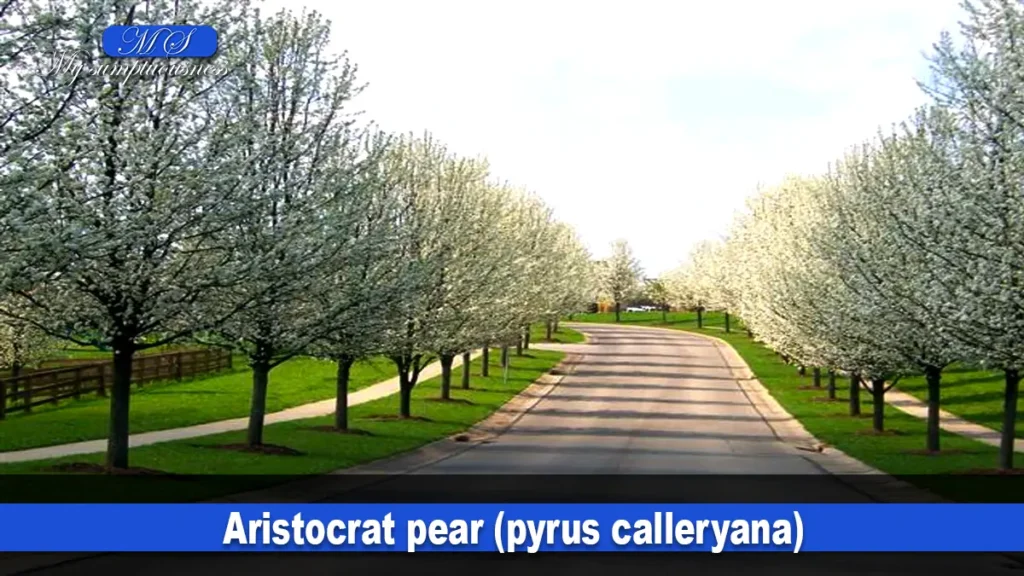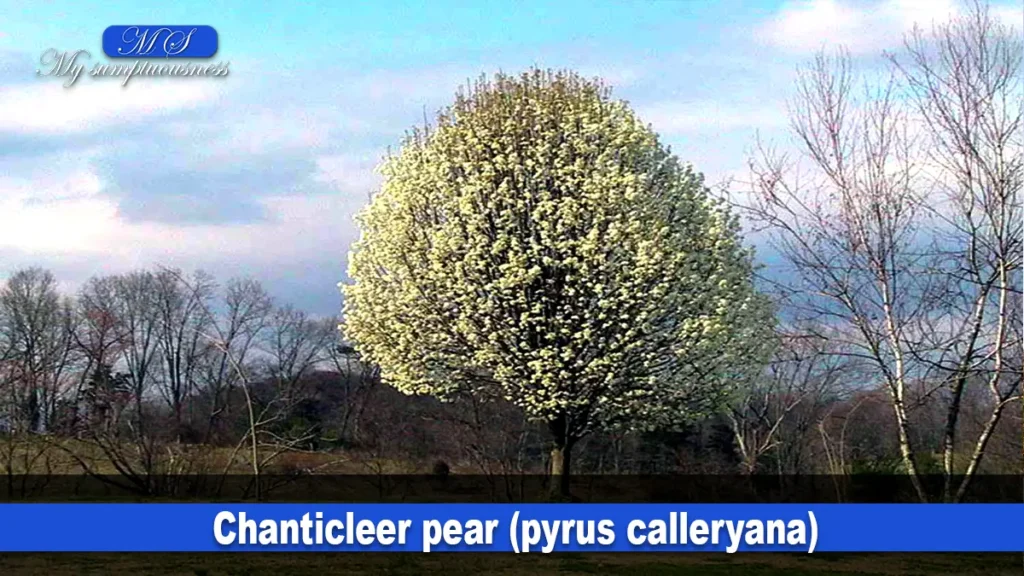Last Updated on 30 September 2023 by mysumptuousness.com
With blossoms of white flowers in spring and orange in autumn, these ornamental pear trees are a popular choice for classic garden designs. Various types of ornamental pear trees are both aromatic and modest. That is why they are becoming increasingly wanted by gardeners who love the traditional garden style. Just like other deciduous plants, including the magnolia, ornamental pear trees are famous for their glossy green leaves, making them the type of tree that really embodies the change of the seasons.
Introduction
The slim trunk of an ornamental pear tree is the best for creating shade without obstructing view-lines around an extensive landmass. While in dense suburban gardens, the height and verdant foliage of the trees provide the best contrast against ground shrubs.
Do types of ornamental pear trees prefer shade or sun?

One can easily find ornamental pear trees at any time of the year. They grow pretty well in a position that receives a great sunbath and is planted in well-draining soil.
Some varieties of ornamental pear trees, including glen’s form chanticleer and capital, are liable to fast wind damage, so it is better to place them somewhere in the garden that is safe from strong wind.
How to plant an ornamental tree
Mostly ornamental trees are sold along with a root ball in a bag. All we just need is to gently remove the tree from the bag and loosen the roots with our hands. It is good to cut off any roots if it is tangled.
Plant in a hole that is double broad than the root ball and backfill until the top of the root ball meets the ground level. If feasible, try creating a ring of soil around the bottom of the plant to help capture water and reach down to the roots.
Water well until it is well grown. Once grown, water regularly and deeply 1-2 times a week.
Fruit from an ornamental flowering pear tree

Well, the fruits from ornamental flowering pear trees are not edible for humans; several families of birds happily eat the fruits of ornamental flowering pear trees.
Pruning

Pruning is a necessary part if you want to keep ornamental pear tree leaves to have a balanced appearance. The perfect time to prune ornamental pear tree leaves is in the fall of autumn.
Fertilising

To ensure an ornamental pear grows for years, fertilize it at least twice a year in autumn and in spring using a good fertiliser.
Most popular ornamental pear tree varieties
· Aristocrat pear (pyrus calleryana)

With a rounded shape and beautiful, horizontal branch structure, this medium-sized, fast-growing ornamental pear has glossy green leaves and mind-blowing autumn colors in reds and yellows. The cup-shaped white flowers in spring are the best and are followed by the growth of hard, small, ornamental fruits.
· Bradford pear (pyrus calleryana)

This medium-sized ornamental pear has a pyramid shape. It becomes broader with the growth. The autumn colors are striking, with eyes giving out shades of yellow, red, purple, and orange. Beautiful clusters of open white flowers in spring are worth seeing.
· Manchurian pear (pyrus ussuriensis)

It is the first ornamental pear to blossom in spring. The manchurian pear is a greatly decorative and popular option for parks and also residential areas and gardens. It is a broad, medium-sized tree with a hard, rounded pattern. Pretty light pink buds in spring change into clusters of small, white flowers. In autumn, the leaves turn into a rich, dark red, stunning beauty.
· Red spire pear (pyrus calleryana)

Red spire grows a symmetrical, upright habit and usually grows up to 12 meters in height. The white flowers change into pink, and the green foliage changes into stunning autumnal colors as the weather goes cold.
· Chanticleer pear (pyrus calleryana)

Chanticleer has a wide pyramid with a rounded shape and horizontal branching. It is the most popular ornamental pear planted for street screening, planting, and hedging. Chanticleer is popular for its cluster of white spring flowers and brilliant autumn colors. It is also popular as ‘glens form’ and ‘cleveland select.’
· Capital pear (pyrus calleryana)

With an upright, narrow habit, pyrus capital is the best for street planting and also for parks and residential grounds as an ideal tree. It is the best choice for fewer spaces or compact areas because of their narrowness. Just like other ornamental pears, its main attraction is the white flowers blooming in clusters in spring and the stunning reddish-purple color of the autumn leaves.
FAQS (Frequently Asked Questions)
Pruning ornamental flowering pear trees is quite similar to pruning other trees. Start by breaking out dead branches from the top of the tree. Then, remove the branches that cross over other branches. Finally, cut the remaining unnecessary branches to provide new growth.
If you like to plant any plant under your ornamental pear, one successful process is to use plants that can grow under the pear shade and flowers in winter while the pear tree is completely bare. Such plants are daphne, clivia, osmanthus, and helleborus.
The most attractive feature of this pear tree is the glossy white flowers that bloom before the leaves in the spring. Early spring flowering normally lasts two weeks, but the spring breeze may reduce bloom time. The tree normally flowers in the fall, usually because of some stress factors, such as drought.
Well-pruned ornamental pear tree grows a symmetrical, upright habit and also grows up to 12 meters in height. The white flowers change into pink, and the green foliage changes into stunning autumnal colors as the weather goes cold.
If you feel the ornamental pear tree smell blooming, you may desire to keep a distance. The ornamental pear tree smell can be compared to the smell of human male vomit and semen.
Pruning ornamental pear trees is quite similar to pruning the other trees. Start by breaking out dead branches from the top of the tree. Then, remove the branches that cross over other branches. Finally, cut the remaining unnecessary branches to provide new growth.
The roots of most of the ornamental pear trees are not invasive. But some species do spread fast underground and cause difficulties if they are planted too near together. You can stop and control the spread of these roots by planting them in bunches rather than separately.